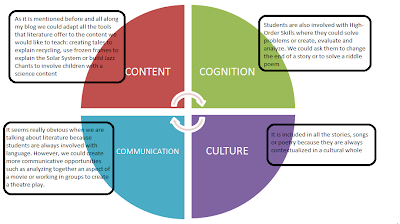Hello Bloggers!
As you probably know the term is ending and that means that this fantastic subject is coming to an end too. That is why
I have decided to make a reflection where I will try to include most of the
things that our teacher Raquel Fernández has taught us.
First of all, I would like to
mention that I am sure that all of us are impressed of how many possibilities working
literature offer. That is why we should not understand literature as reading
alone because…
Literature offer other fruitful and more attractive options!
· TALES could be used written or orally.
It is important that we used them with some scaffolding such as pictures or videos, to help students comprehend their meaning. Moreover, we
should keep in mind that tales are not just stories that we tend to forget
after reading them. The reason is because they offer pre and after reading
possibilities to analyze their meaning and encourage children to keep working with
literature, for instance PERFORMING a
tale
· SONGS are also literature! They could be used in different ways depending on
their purpose. For example: there are songs to improve students’ pronunciation,
as you know, it is the case of YO-YO
PHONICS. If what we want is to deal with hidden messages we could use NURSERY RHYMES, they are easy to
memorize due to their rhythm. Another
good tool are JAZZ CHANTS, they are
really flexible because you could include the content you want using the guidelines
established by Carolin Graham. Jazz Chantz are useful to help students memorize
content or vocabulary.
· POETRY is not as boring as you think! It usually
seems tricky for our students however it depends on how you apply it in your
lessons. You could create different working corners where in groups students
explore different types of poems. You could enhance them using RIDDLE POEMS where they have the challenge
to solve some problems or LIST POEMS where
they could add one more verse.
· THEATRE offers us also different possibilities. We
could use FROZEN FRAMES to review or
check a content. Also, they could be used to create comic situations where
students should guess what is happening. Another option is DRAMATIC PERFORMANCE where students could read aloud a text emphasizing
expressions.
Moreover, literature could be
perfectly implemented in a
Bilingual context for several reasons:
- It deals with the 4C's and as we all know they are essential elements of all CLIL lessons (please click on the picture to see detailed explanation)
- Students are learning content and English at the same time with the help of scaffolding: activating pre-knowlegde, use of visual tools, contextualizing, modelling, bridging, schema building, re-presenting text or developing metacognition
- Literature could cater different learners' needs through the implementation of all multiple intelligences
In conclusion, I would like to
mention that with literature is possible create meaningful learning
experiences where students learn content without realizing they are doing it!
Moreover, literature also offer motivating contact that encourage learners to
keep working with different activities that help them to improve their
self-esteem. Also, as we could see along the subject the resources that we
could used are very different and creative for children.
Finally, I would like to thank our
teacher Raquel Fernández for all the things we have learnt with her. It has
been an excellent experience where we all have discovered many things and have spent a great time!
Classmates! It has been a pleasure reading all your blog
reflections!
See you soon!
























